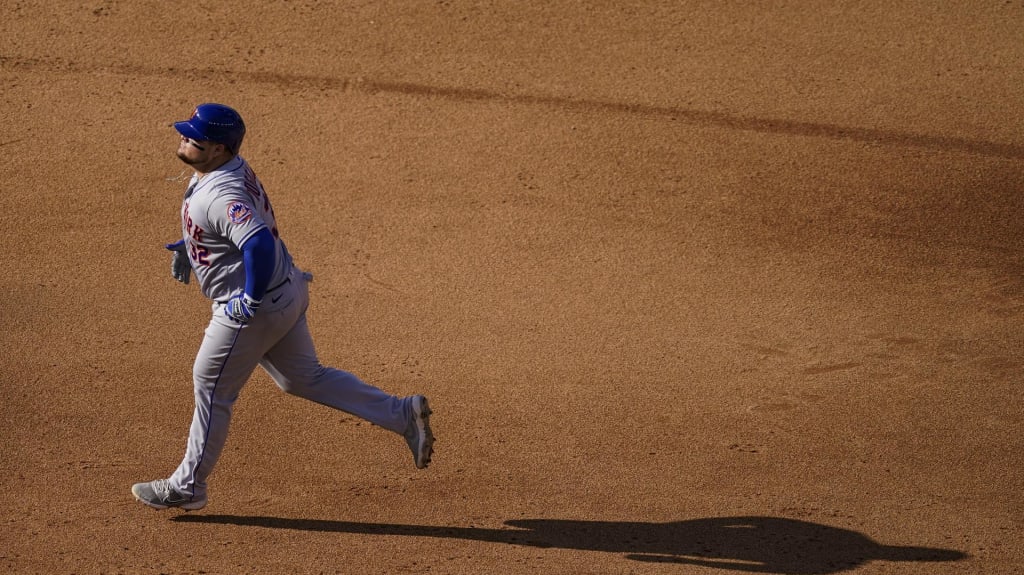
This story was excerpted from Anthony DiComo's Mets Beat newsletter. To read the full newsletter, click here. And subscribe to get it regularly in your inbox.
Eager to make a splash at the 2021 Trade Deadline, the Mets dealt their fifth-ranked prospect, 2020 first-round Draft pick Pete Crow-Armstrong, for two months of Javier Báez and a year-plus of Trevor Williams.
They’ve at least partially regretted it ever since.
Although Báez (thumbs-down episode notwithstanding) was productive for the Mets down the stretch, and Williams has been a glue guy for their pitching staff this year, the Mets missed the playoffs in 2021. And the cost was significant. Crow-Armstrong, who was injured at the time of the deal, is healthy now and is thriving in the Minors as the No. 75 prospect in baseball. Were he still in the Mets organization, Crow-Armstrong would rank fourth on their MLB Pipeline list behind Francisco Álvarez, Brett Baty and Ronny Mauricio.
Billy Eppler wasn’t the Mets’ general manager at the time of that deal, but he’s determined to avoid repeating the mistake, which is the simplified reason why he did not acquire a catcher or a left-handed pitcher prior to this year’s Deadline. Although Willson Contreras, Sean Murphy or one of many lefty relievers could have helped the Mets, Eppler considered the cost too significant.
“Some of that undisciplined thinking can lead to years of mediocrity and doing the same thing over and over and over again,” Eppler said. “One of the things we’ve talked about here is just really trying to maintain that organizational discipline, to crush any urge to make a snap or an impulsive decision and give up large amounts of future World Series odds or expectation in exchange for just some marginal gains right now.”
Within that answer, Eppler referenced the fact that when Mets officials evaluate trades, they do so using analytical models -- common practice around the league. Replacing Dominic Smith with Daniel Vogelbach, for example, will increase their odds to win a championship by a certain percent. Parting with Colin Holderman in that same deal will decrease their odds in future seasons.
Mets owner Steve Cohen has been vocal in his desire to build something sustainable in Flushing, which in Eppler’s eyes meant navigating the Trade Deadline without spending any of the organization’s “Top 19 prospects.” It’s a group that includes Álvarez, Baty, Mauricio, Mark Vientos, Alex Ramírez, Matt Allan and about a dozen others. Statistically speaking, most of those players will not develop into stars. But if the Mets keep their list of potential impact prospects long enough, it will create a pipeline of future contributors and trade chips.
The counterargument is that rationality does not win titles. As Dodgers president of baseball operations Andrew Friedman once said in reference to the winter Hot Stove season, “If you’re always rational about every free agent, you will finish third on every free agent.” The Dodgers have made deals in the past that many would consider irrational, swinging Deadline blockbusters for Yu Darvish, Trea Turner, Max Scherzer and others. They’ve remained extremely competitive due to their deep pockets and ability to continue infusing their farm system with talent. The Dodgers are not just richer than most teams in baseball; they’re smarter, too.
It’s a place the Mets yearn to reach, and they were willing to sacrifice incremental improvements to this year’s roster to do so. The price on Contreras remained high enough that no club acquired him, despite the fact that he plays for a fourth-place team and can become a free agent after this season. (Chicago’s only incentive to keep its starting catcher was to extend him a qualifying offer this winter, and to increase its odds of re-signing him.)
The Mets never came close on Contreras, according to a source. They did nearly acquire some lefty pitching, Eppler said, but couldn’t strike a deal despite significant inventory around the league. As an example, a person familiar with negotiations said the Tigers was seeking multiple offensive pieces for lefty closer Gregory Soto; the Mets had little interest in dealing players such as Vientos or Mauricio for a relief pitcher.
In one sense, this represents sound strategy, because the Mets figure go as far as Jacob deGrom and Scherzer take them. If either of those two suffers another injury, the team may not be able to recover. And if both are healthy, how much difference will a lefty reliever make?
But in another sense, the Mets’ current window of contention appears small. deGrom is 34 with a significant injury history and may be playing his final season as a Met. Scherzer is 38 with a growing list of aches and bruises. Taijuan Walker, Chris Bassitt and Carlos Carrasco can all become free agents after this season. If ever there was a year to do something irrational, this might be it -- even if it means sacrificing the next Crow-Armstrong, whose ultimate value is still unknown.


